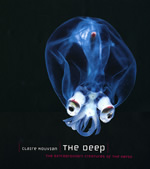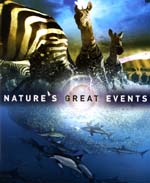Celebrate Earth Day with Books!
Today is Earth Day, a time to reflect on the wonders and fragility of our planet’s diverse environments. As CNN.com reported this morning, more than one billion people are expected to commemorate the occasion in 175 countries. Both the New York Times and the Environmental Protection Agency are encouraging Earthlings to appreciate their home by taking photographs of it. And it is in that vein that we present books that contain of astonishing images of the planet and the various creatures with whom we share it.
 On dry land, most organisms are confined to the surface, or at most to altitudes of a hundred meters—the height of the tallest trees. In the oceans, though, living space has both vertical and horizontal dimensions: with an average depth of 3800 meters, the oceans offer 99% of the space on Earth where life can develop. And the deep sea, which has been immersed in total darkness since the dawn of time, occupies 85% of ocean space, forming the planet’s largest habitat. Yet these depths abound with mystery. The deep sea is mostly uncharted—only about 5 percent of the seafloor has been mapped with any reasonable degree of detail—and we know very little about the creatures that call it home. Current estimates about the number of species yet to be found vary between ten and thirty million. The deep sea no longer has anything to prove; it is without doubt Earth’s largest reservoir of life. Combining the latest scientific discoveries with astonishing color imagery, The Deep takes readers on a voyage into the darkest realms of the ocean. Revealing nature’s oddest and most mesmerizing creatures in crystalline detail, The Deep features more than two hundred color photographs of terrifying sea monsters, living fossils, and ethereal bioluminescent creatures, some photographed here for the very first time. Check out images on the book’s website.
On dry land, most organisms are confined to the surface, or at most to altitudes of a hundred meters—the height of the tallest trees. In the oceans, though, living space has both vertical and horizontal dimensions: with an average depth of 3800 meters, the oceans offer 99% of the space on Earth where life can develop. And the deep sea, which has been immersed in total darkness since the dawn of time, occupies 85% of ocean space, forming the planet’s largest habitat. Yet these depths abound with mystery. The deep sea is mostly uncharted—only about 5 percent of the seafloor has been mapped with any reasonable degree of detail—and we know very little about the creatures that call it home. Current estimates about the number of species yet to be found vary between ten and thirty million. The deep sea no longer has anything to prove; it is without doubt Earth’s largest reservoir of life. Combining the latest scientific discoveries with astonishing color imagery, The Deep takes readers on a voyage into the darkest realms of the ocean. Revealing nature’s oddest and most mesmerizing creatures in crystalline detail, The Deep features more than two hundred color photographs of terrifying sea monsters, living fossils, and ethereal bioluminescent creatures, some photographed here for the very first time. Check out images on the book’s website.
 Our planet is host to some of nature’s most amazing events—both stunning and deadly. Take for instance the flooding of the Okavango Delta in Botswana, which turns sprawling swaths of desert into an elaborate maze of lagoons and swamps. Or the melting of 10 million square kilometers of ice in the Arctic, which imperils polar bears across the region. The lavishly illustrated counterpart to the Discovery Channel’s landmark wildlife documentary, Nature’s Most Amazing Events (to air May 29-31), Nature’s Great Events charts six seasonal events that transform entire ecosystems and the life experiences of the thousands of animals within them, from the largest mammals to the smallest microorganisms. These include the migration of the Serengeti, where life is on the edge for both predator and prey and where lions and wildebeest battle to survive; the great salmon run in British Columbia, where rivers teem with thousands of fish—and where grizzlies and wolves eagerly await them; the explosion of sea life in Alaska’s coastal waters, where countless animals from far and wide brave killer whales to feed; and the greatest marine spectacle on the planet, the annual tide of sardines along South Africa’s east coast, where the greatest concentration of predators—including sharks and dolphins—come to feast. Using groundbreaking filming techniques and state-of-the-art scientific technologies, the book and the documentary on which it is based are epic in every sense. See videos from the BBC series and sample pages (PDF format, 1.9Mb).
Our planet is host to some of nature’s most amazing events—both stunning and deadly. Take for instance the flooding of the Okavango Delta in Botswana, which turns sprawling swaths of desert into an elaborate maze of lagoons and swamps. Or the melting of 10 million square kilometers of ice in the Arctic, which imperils polar bears across the region. The lavishly illustrated counterpart to the Discovery Channel’s landmark wildlife documentary, Nature’s Most Amazing Events (to air May 29-31), Nature’s Great Events charts six seasonal events that transform entire ecosystems and the life experiences of the thousands of animals within them, from the largest mammals to the smallest microorganisms. These include the migration of the Serengeti, where life is on the edge for both predator and prey and where lions and wildebeest battle to survive; the great salmon run in British Columbia, where rivers teem with thousands of fish—and where grizzlies and wolves eagerly await them; the explosion of sea life in Alaska’s coastal waters, where countless animals from far and wide brave killer whales to feed; and the greatest marine spectacle on the planet, the annual tide of sardines along South Africa’s east coast, where the greatest concentration of predators—including sharks and dolphins—come to feast. Using groundbreaking filming techniques and state-of-the-art scientific technologies, the book and the documentary on which it is based are epic in every sense. See videos from the BBC series and sample pages (PDF format, 1.9Mb).
So remember, this Earth Day: Reuse, recycle, read.